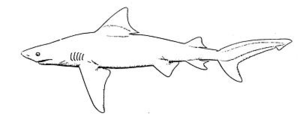Bull shark
|
|
| Bull Shark Conservation status: Lower risk (nt) | ||||||||||||||||
|---|---|---|---|---|---|---|---|---|---|---|---|---|---|---|---|---|
 | ||||||||||||||||
| Scientific classification | ||||||||||||||||
| ||||||||||||||||
| Binomial name | ||||||||||||||||
| Carcharhinus leucas (Müller and Henle, 1839) |
Bull sharks are common in warm, shallow waters along coasts throughout the world. They are, due to their habits, probably responsible for the majority of attacks on humans that take place near shore, including many attacks attributed to other species. Bull sharks can travel inland by swimming up rivers, and have a unique tolerance for fresh water. Those found far from the ocean are the same species as the seaborne Bull shark, and are not true freshwater sharks (unlike the Bull sharks in Lake Nicaragua and the river sharks of the genus Glyphis).
| Contents |
Description
Bull sharks are large. The males of this species can reach 2.1 m long and weigh 90 kg. The females can be much larger, 3.5 m long and 230 kg. The name, "bull shark," comes from its stocky shape and broad, flat snout.
Behavior
Bull sharks are mostly-sluggish, solitary animals who cruise through shallow waters taking a wide variety of prey: fish, other sharks, rays, turtles, birds, mollusks, and crustaceans. They seem not to view humans as prey under normal conditions, but will bite out of curiosity or when threatened, or in water where visibility is poor and a human might easily be mistaken for a prey animal. Despite their apparent docility at times, they are capable of surprising bursts of speed, and can be highly aggressive. Their aggression is fueled by testosterone. The bull shark has the highest testosterone levels of all animals. Like all sharks, their behavior is poorly-understood and can seem unpredictable.
Bull sharks are found in salt water from depths of about 30 meters, to fresh and salt water as shallow as 75 cm. They are found in the central Amazon River, and have been recorded as far up the Mississippi River as Illinois. They are also found in the fresh water Lake Nicaragua.
Attack Patterns
Bull sharks will attack almost anything that is moving or living. It will first brush its nose against the prey item before attacking.
Reproduction
Breeding takes place in the summer, often in brackish water of river mouths. After a gestation of about a year, bull sharks give birth to as many as 13 live young (they are ovoviviparous). The young are about 70 cm long at birth and take as long as 10 years to reach maturity.
Pictures of Animals
- Classroom Clipart Pictures and Photos of Animals (http://classroomclipart.com/cgi-bin/kids/imageFolio.cgi?direct=Animals)
Animal Clipart
- Animal Clipart (http://classroomclipart.com/cgi-bin/kids/imageFolio.cgi?direct=Clipart/Animals)
External link
- MarineBio: Bull shark, Carcharhinus leucas (http://marinebio.org/species.asp?id=83)
| Shark articles | |
|---|---|
| Angel | Basking | Blacktip Reef | Blue | Bull | Carpet | Cat | Cookiecutter | Freshwater | Frilled | Goblin | Gray Reef | Grey Nurse | Great White | Hammerhead | Mako | Megamouth | Nurse | Oceanic Whitetip | Porbeagle | Requiem | River | Sand | Sandbar | Saw | Silky | Sleeper | Smooth dogfish | Thresher | Tiger | Whale (shark) | Whitetip reef | Wobbegong | Zebra / Leopard | |
| Extinct shark species | |
| Megalodon | Cladoselache | Squalicorax
|
